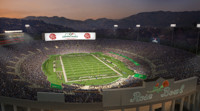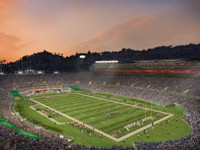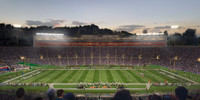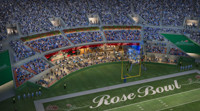Rose Bowl
| Capacity | 72 000 |
|---|---|
| Country | United States of America |
| City | Pasadena |
| Clubs | UCLA Bruins |
| Category | Design being implemented |
| Cost | $80 M |
| Construction | 2024–2029 |
| Design | Gensler |
Advertisement
Rose Bowl – design description
What are the Rose Bowl renovation plans in brief?
The renovation of the historic Rose Bowl includes eight separate projects, divided into two phases: the first six are scheduled for 2024–2026, and the remaining two for 2028–2029.
The main task in the first phase will be the redevelopment of the south stand, where a new VIP area is planned at field level. This phase also includes upgrading the sound system and improving telecommunications infrastructure.
These works will better prepare the stadium for the 2028 Olympic Games, which will be the third in Rose Bowl’s more than century-long history. The stadium will host matches of the Olympic football tournament for both men and women, including both finals.
The second phase of renovation is planned to take place after the Olympics. It will cover two projects: the redevelopment of the sideline seating, which will reduce the stadium’s capacity to 70–72,000 spectators, and the installation of one of the largest video boards in the United States.
What is the Rose Bowl like?
Rose Bowl was built in 1922, initially in a horseshoe shape. The missing south stand was added in 1928, and the stadium’s basic form has remained largely unchanged since. The most recent major investment was the expansion of the press box building on the west side, carried out between 2011 and 2013.
The stands have a fairly simple oval shape and are not covered. With a capacity of nearly 90,000, Rose Bowl ranks among the top twenty largest stadiums in the world. The stadium is located in Pasadena, about 10 miles (16 km) northeast of downtown Los Angeles, and is recognized as a National Historic Landmark.
Rose Bowl is one of the most iconic sports venues in the United States. It has hosted men’s (1994) and women’s (1999) FIFA World Cup finals, as well as the football final of the 1984 Olympic Games. During the first Los Angeles Olympics in 1932, track cycling events were also held at Rose Bowl.
The stadium has hosted the Super Bowl five times, and at the beginning of every year it is home to the traditional Rose Bowl Game. Since 1982, the UCLA Bruins football team, representing the University of California, Los Angeles (UCLA), has regularly played at the stadium. Rose Bowl also frequently hosts concerts by major music stars and many other events.
How did the Rose Bowl renovation project come about?
What prompted the new renovations at Rose Bowl?
In 2028, Los Angeles will host the Summer Olympic Games for the third time – and for the third time, Rose Bowl will be one of the Olympic venues, hosting both men’s and women’s football matches, including their finals.
In addition, the UCLA Bruins moved from the Pac-12 Conference to the Big Ten Conference ahead of the 2024 season, providing an impetus for further significant investments in the stadium.
When were the Rose Bowl renovation plans announced?
In the fall of 2024, the stadium’s sound system was replaced, and safety railings were installed in the lower rows of the east stand, converting them into safe standing areas. The iconic “Rose Bowl” sign on the south facade was also renovated.
On December 2, 2024, Rose Bowl Operating Company, managing the stadium on behalf of the city, together with the collaborating nonprofit organization Rose Bowl Legacy Foundation, announced plans for the stadium renovation, comprising eight projects to be carried out over several years.
Alongside the renovation plans, prepared in cooperation with the Gensler studio, The Lasting Legacy Campaign was also announced – a fundraising campaign aimed at securing the necessary resources to complete the works.
What do the Rose Bowl renovation plans entail?
When will the Rose Bowl renovation take place?
The renovation has been divided into two phases: the first is scheduled for 2024–2026, and the second is planned for after the Olympic Games, in 2028–2029. Three projects already completed in the fall of 2024 are also considered part of the overall investment: the replacement of the sound system, safe standing areas on the east stand, and the renovation of the “Rose Bowl” sign.
What projects are included in the Rose Bowl renovation plan?
The entire plan consists of eight projects, six of which are scheduled for the first phase (2024–2026), and two for the second phase (2028–2029). Of the six projects in the first phase, three were completed in the fall of 2024, and funding has already been secured for the remaining three. The implementation of the two projects planned after the Olympic Games will depend on the availability of additional funds.
Projects scheduled for the first phase (2024–2026):
- Renovation of the “Rose Bowl” sign on the south facade (completed fall 2024)
- Safe standing areas in the lower section of the east stand (completed fall 2024)
- Replacement of the sound system (completed fall 2024)
- New VIP area in the south end zone
- Reconstruction of gas and water systems
- Upgrades to the telecommunications infrastructure
Projects planned for the second phase, after the Olympic Games (2028–2029):
- Changes to the seating layout in the east and west stands – reducing stadium capacity to 70–72,000 spectators
- New video board on the north curve
How much will the Rose Bowl renovation cost?
The renovation is expected to cost $75–85 million. Funding will come from donations and contributions from business partners. The first phase is estimated at $30–35 million, while the second phase will require an additional $45–50 million.
What will the Rose Bowl renovation achieve?
The upgrades planned for 2024–2029 aim to modernize the Rose Bowl, raising the stadium’s standards and improving fan comfort. The venue will be ready to host Olympic events and other major competitions, maintaining its competitiveness among regional sports arenas and continuing its century-long tradition.
At the same time, the changes are not intended to be radical, and the stadium is expected to retain its current form and character. Once its capacity is reduced to 70–72,000, the Rose Bowl will, however, cease to be considered one of the largest stadiums in the world.
What do the particular projects of the first phase of the Rose Bowl renovation involve?
The first phase (2024–2026) includes six separate projects, three of which were already completed in the fall of 2024. The main undertaking will be the reconstruction of the south stand to create a new VIP area.
Renovation of the “Rose Bowl” sign
One of the projects completed in fall 2024 was the renovation of the iconic “Rose Bowl” sign, which adorns the stadium’s most prominent south facade. The sign was originally installed in the 1950s, and in recent years, problems with the electric lighting had begun to appear.
After the renovation, the sign now has a more striking appearance, and its operators can change the color of the letters. The renovation cost approximately $300–400,000.
Safe standing areas on the east stand
In fall 2024, the lower section of the east stand was also renovated. Metal railings were installed in the eight lowest rows, in the area reserved for UCLA students, allowing spectators to safely stand and cheer.
Replacement of the sound system
Another project completed in 2024 was the replacement of the stadium’s sound system.
VIP area in the south end zone
The main project of the first phase of the Rose Bowl renovation is the creation of a new VIP area behind the south end zone. To achieve this, the lower part of the south stand will be rebuilt, and the space previously occupied by the lower rows of seating will be replaced by premium suites at field level.
The new premium area will be partly outdoors and partly under the stands. It will accommodate over 750 guests and will be located close to the players’ tunnel. During concerts, it can serve as a backstage area for performers and production crews. The VIP area will retain an elliptical shape, consistent with the rest of the stadium.
The construction cost of the VIP area is $20 million. Work is scheduled to begin in January 2026 and finish in the fall of the same year.
Reconstruction of gas and water systems
The stadium’s gas and water systems are in some areas over fifty years old and require comprehensive modernization.
Upgrades to telecommunications infrastructure
Modernizing the telecommunications infrastructure will allow full use of 5G networks and improve safety by strengthening emergency communication systems.
What do the projects of the second phase of the Rose Bowl renovation involve?
The second phase of work is scheduled to take place after the Olympic Games (2028–2029) and will include two projects: reconfiguring the seating along the sidelines (which will significantly reduce the stadium’s capacity) and installing one of the largest video boards in the United States on the north end zone.
Changes to the seating layout on the east and west stands
In the second phase, major changes will be introduced to the stands along the sidelines. An additional layer will be built over the existing concrete terraces, with the number of rows reduced from 77 to around 50.
This will give spectators more legroom (around 4–6 inches), but the overall capacity of the stadium will decrease substantially – from just under 90,000 to around 70,000–72,000. The project also calls for dividing the seating areas into smaller sections to increase the number of aisles. This task is expected to cost $20 million.
New video board on the north end zone
A new video board is planned for the north end zone, set to become one of the largest in the entire United States. The screen will be wide but not too tall, so as not to obstruct views of the distant mountains.
It will be slightly curved to follow the oval contour of the stands and built on an independent structure so as not to put additional load on the existing one. The video board will be the most expensive project within the entire renovation plan, with costs estimated between $25 and $30 million.
Advertisement

 StadiumDB
StadiumDB





